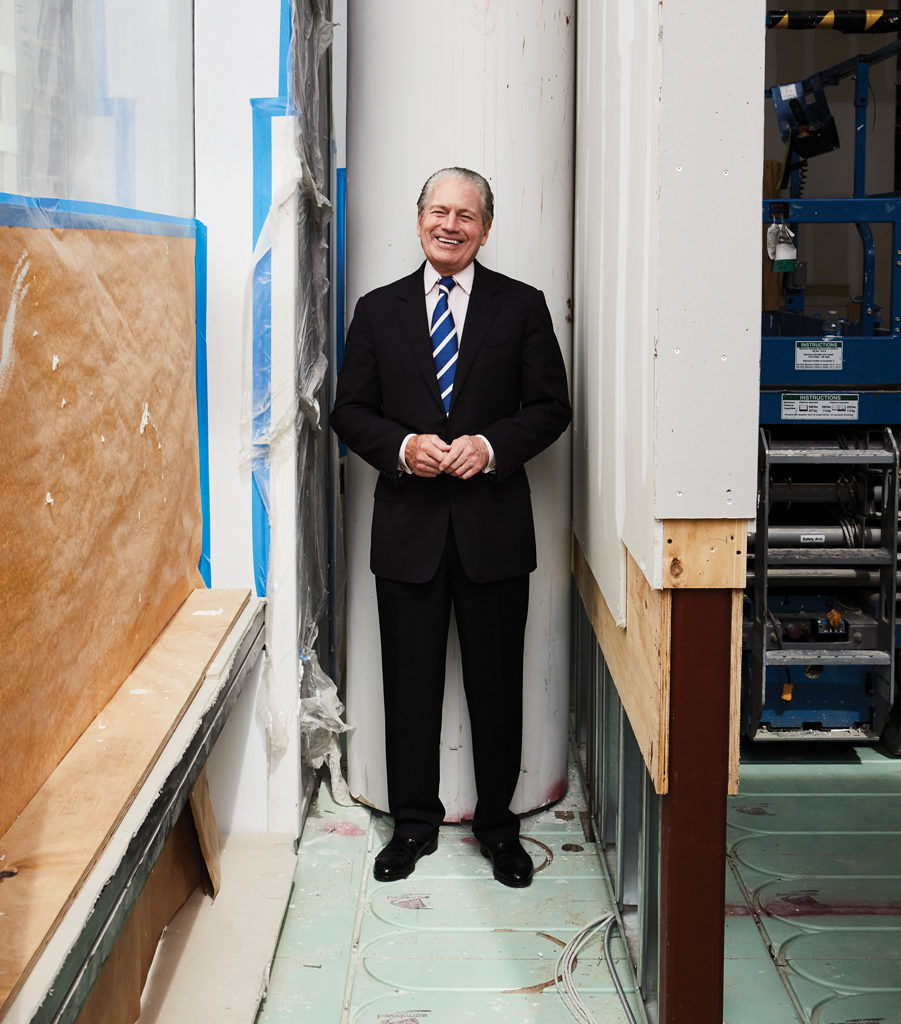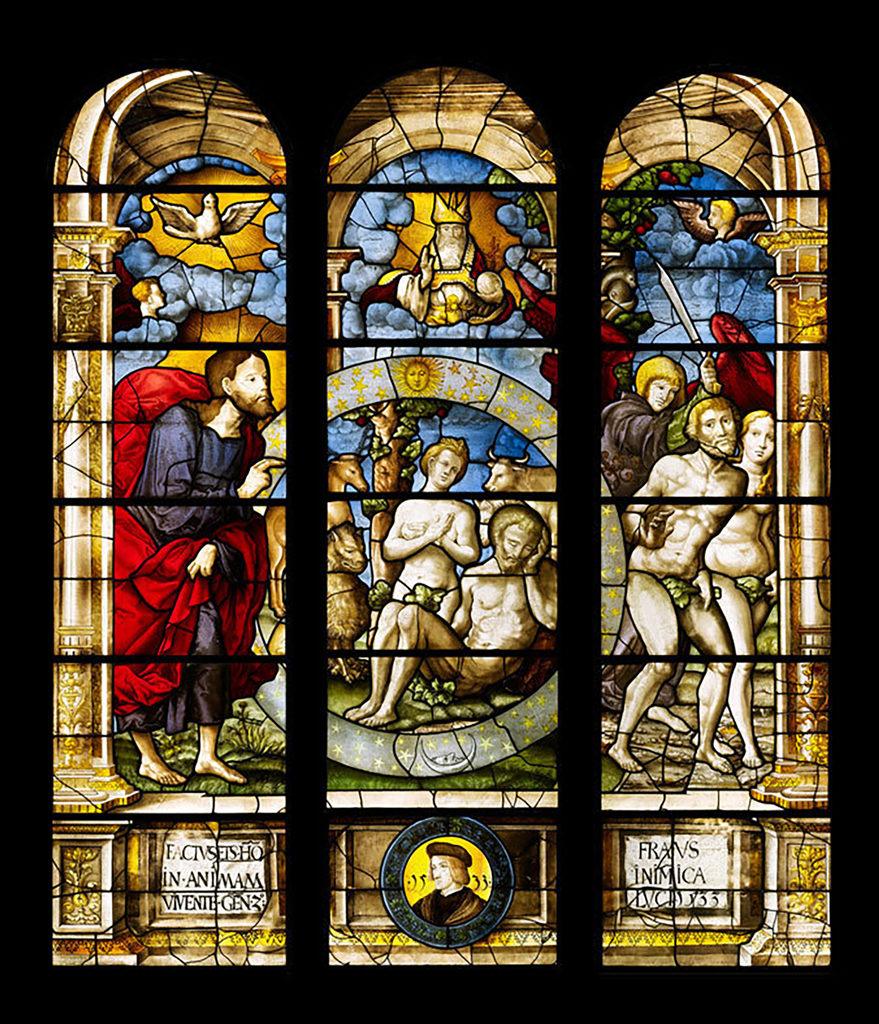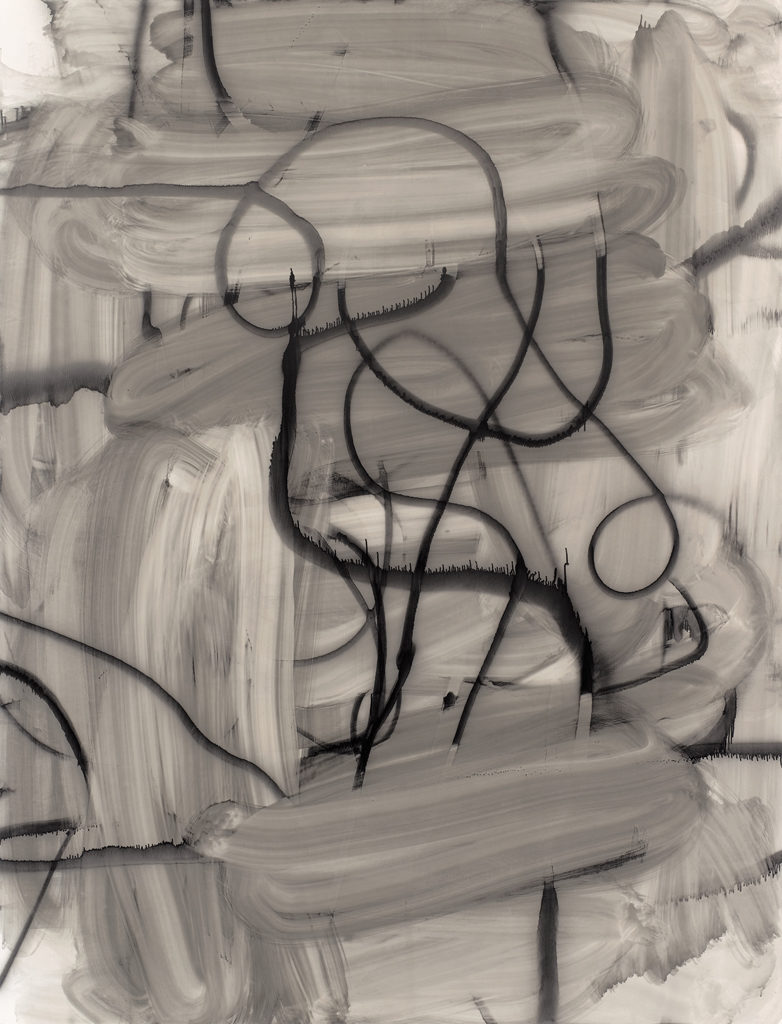[ad_1]

J. Tomilson Hill photographed on July 30, 2018 at the under-construction Hill Art Foundation in New York City.
MELANIE DUNEA
In early 2019 visitors to the High Line, the elevated park that runs through the Chelsea gallery district in New York, will have the rare opportunity to view The Creation of the World and the Expulsion from Paradise, a 1533 stained-glass window painted by Renaissance artist Valentin Bousch. The work, which sits in a window overlooking the park, was once owned by William Randolph Hearst, and is just one of the many pieces that the new Hill Art Foundation will bring to Chelsea when it opens its doors on the second and third floors of the Getty, the 12-story Peter Marino–designed development on West 24th Street.
The Hill Art Foundation is the brainchild of collector J. Tomilson Hill (best known as “Tom”) and his wife, Janine. The couple has assembled a world-class collection of more than 400 works, valued at over $800 million. These include modern, contemporary, Old Master, and Renaissance objects. Hill is on the board of the Metropolitan Museum of Art and Friends of the High Line, and his wife sits on the board of the Hirshhorn Museum and Sculpture Garden in Washington, D.C.
Inaugurating the foundation’s 6,400-square-foot public exhibition space will be a selection of 21 paintings by Christopher Wool, all culled from the Hills’ collection. Admission will be free. This past June, Sarah Needham, who formerly worked at the Stavros Niarchos Foundation, became the exhibition space’s director, charged with overseeing operations and exhibitions, maintaining the collection, and launching a full-scale educational program.
Inside the couple’s Upper East Side apartment, also designed by Marino, Hill was sitting in his study, beneath Peter Paul Rubens’s 1608 Portrait of a Commander and opposite Study for Portrait II, a 1956 “Pope” painting by Francis Bacon. Installed in the foyer just outside is Willem de Kooning’s sculpture The Clam Digger (1972). Books and catalogues devoted to every artist in the collection pack the study. The apartment is one of 10 homes Marino has designed for the Hills, who will soon be moving into another, a $30 million apartment on Fifth Avenue, overlooking Central Park.
Hill grew up in New York City, where he regularly made the rounds of museums under the influence of his artist mother. He would also visit the home of William Burden, then the president of the Museum of Modern Art, with his father, who was a partner in the investment firm William A.M. Burden Company, and there discovered the art of collecting.
He attended Harvard University, where he dabbled in photography and worked for the Harvard Lampoon, and earned an M.B.A. at Harvard Business School. He met Janine in the 1970s, when he was working at First Boston and she was a lawyer at Sullivan & Cromwell. They married in 1980.
Early in their marriage, the Hills acquired still life paintings by the 19th-century Danish artist Johan Laurentz Jensen, but when they moved into their current home in 1994, they decided to collect more seriously and broadly. Marino helped the couple draw up a list of eight artists they would collect in-depth: Andy Warhol, Francis Bacon, Willem de Kooning, Cy Twombly, Roy Lichtenstein, Ed Ruscha, Brice Marden, and Lucio Fontana—a group Hill likes to call game changers. Within a few weeks, they acquired one of their first Warhols, Campbell’s Soup I: Consommé (Beef), which was one of the works featured in the artist’s historic Ferus Gallery show in Los Angeles in 1962. They paid $340,000.

Valentin Bousch, The Creation of the World and the Expulsion from Paradise, 1533.
COLLECTION OF MR. AND MRS. J. TOMILSON HILL
“Ideally, I want an artist who has done great work in every decade they have lived,” said Hill, who deaccessioned his one Jean-Michel Basquiat because the artist’s career lasted less than a decade; he also sold his one work by Rothko when he found he could not buy three others of equal quality. More recently, he added other artists to the mix, including Wool, Mark Grotjahn, Agnes Martin, Robert Gober, and Rudolph Stingel. Under the influence of his daughter, Astrid, an art adviser, Hill is also now assembling works by such young and mid-career women artists as Sarah Crowner, Sam Moyer, and Mika Tajima, as well as Chinese artists, including Wang Guangle and Liu Wei.
“I am only interested in art that is not a ‘flash in the pan,’ ” said Astrid, who will play a key role in the foundation, curating shows of younger artists and developing the education program with Needham. When advising her father, she looks for artists and artworks that are “exploring completely new ground” and that stand up competitively with the game changers in the collection.
But that mix includes historic as well as new artists. “One of the most interesting things is the way that [Tom] mixes his collection together, and thoughtfully,” said Ian Wardropper, director of the Frick Collection, which exhibited Hill’s collection of Renaissance and Baroque bronzes in 2014. Here, miniature sculptures by Andrea Riccio, Giambologna, and Adriaen de Vries punctuate every tabletop and side board. Beneath Ruscha’s Seventeenth Century (1988)—a depiction of a threatening sky emblazoned with the words “plague,” “melancholia,” and other ominous phrases—is a lineup of Giambologna’s bronze models cast by Antonio Susini, a fitting combination.
Wardropper admitted that bringing works by Twombly and Ruscha into his museum was something of a challenge for his typical audience. “[Hill] has reasons for placing a bronze in front of [contemporary] painting; sometimes it is formal relationships, and sometimes it is more conceptual, but he really thinks about it,” he said.
Hill is also an astute businessman—some liken him to Gordon Gecko in Oliver Stone’s 1987 film Wall Street, based on his dapper attire and slicked-back hair. But he is not a typical investor-collector. After a decade at Lehman Brothers in the 1980s, he joined Blackstone Group in 1993, where, as CEO of Blackstone Alternative Asset Management (BAAM), the firm’s hedge-fund business, assets rose from $1.3 billion in 2000 to $75 billion today. He recently transitioned to chairman of BAAM, in order to devote more time to philanthropy.
When asked how his business acumen has influenced his collecting, he said, “If you are in the business of investing, you better have done your research. You better have a clear view as to what the strategy is and where the company is going to be three years, five years, ten years from now, and you better have a view as to whether essentially the company is a survivor or not. So I always ask myself in terms of choosing artists: Are they doing new work?
Is it innovative? Do they have the potential to be game changers?” According to Hill, the major artists in his collection all meet these criteria, altering the way people look at art and influencing younger generations of artists.
“As a collector, Tom Hill is a super-rare breed,” said Marc Glimcher of Pace Gallery, which represents Wang Guangle. “He is obviously best known as the guy who collects in depth, but it’s more than just that. He really wants to see where the art comes from, and he really believes that the artists are extraordinary people who really can do extraordinary things.” Glimcher sees parallels between Hill’s self-imposed demand to do extensive research and get to know the artists well, and the success of Blackstone, whose history has been to “look into situations that other people did not understand and see opportunities that had nothing to do with the crowd.”
But Hill’s research in art has little to do with investment, since he almost never sells work from his collection or thinks about making a profit. He has been known to pay top dollar, like the $30 million he spent for his Francis Bacon “Pope,” learning early on that it was foolish to try to skimp and, as a result, lose out on an important work. (Of course, his picks do often turn out to be “best buys” as in the case of the 1970 Twombly “blackboard” he bought in 2002 for $6 million; a similar work sold in 2015 at Sotheby’s for a record $70 million.)
“Tom has such a laser-like focus on quality, and his knowledge and enthusiasm for the works he collects is so broad,” said Sean Kelly, who represents Sam Moyer and chose Hill as the first collector to interview for Kelly’s new podcast, “Collect Wisely.” Kelly and Hill talked for an hour, all about artists. “I’m sure,” said Kelly, “in every other walk of life, he is the consummate businessman, but as a collector, he does not react like a businessman at all. His entire focus is on connoisseurship and quality. He wants the best and he’ll pay for it.”

Christopher Wool, Untitled, 2007, will be on view at the inaugural show at Hill Art Foundation.
©CHRISTOPHER WOOL/COURTESY THE ARTIST AND LUHRING AUGUSTINE, NEW YORK/COLLECTION OF MR. AND MRS. J. TOMILSON HILL
Hill gave the world a glimpse into his collection and the direction of his new foundation this past March in Hong Kong when he unveiled 15 paintings and works on paper by Wool. It was the inaugural show in the atrium of the new art development, H Queen’s, where David Zwirner, Pace, and Hauser & Wirth have opened galleries. Around 10,000 visitors came through to see Wool’s paintings, ranging from his text-based Untitled (PRANKSTER), 1989, to a 2015 black-and-white abstraction. It was the artist’s first museum-quality show in Asia and the first time an American collector had staged such an exhibition in Asia.
“I’m really interested in the evolution of taste and I’m also very interested in markets,” said Hill, who has been doing business in Asia since the 1980s. To find out what Wool’s collector base in the region was, he spoke with Luhring Augustine, the gallery representing Wool; Rachel Lehmann of Lehmann Maupin gallery, who is also moving into the Getty building in Chelsea; and Japanese dealer Taka Ishii, among others. He learned it was no more than a dozen collectors, and probably none in China. “I asked what if we put together a museum-quality show to show how great an artist he is in the history of abstraction, and I said, I can do it through my foundation,” Hill said. He dismissed the idea that, in doing the show, he would only create more competition for himself in getting Wool’s best works. “I am willing to run that risk because part of the foundation is educational, and Christopher is the only major artist that we collect who doesn’t really have a global audience,” he said. During the course of the weeklong exhibition, Hill organized panel discussions with such Wool experts as Richard Armstrong, director of the Guggenheim Museum, where the artist had a retrospective in 2013, and Neal Benezra, director of SFMoMA.
“Tom’s feeling is that Christopher is a real crucial artist of his generation and very influential with younger artists,” said Lawrence Luhring, cofounder of Luhring Augustine gallery, who has helped Hill assemble his trove of Wools in less than ten years. “He started slowly, and then the momentum increased as he really decided at some point a few years ago that he wanted to represent all aspects of the work; then he really geared up and did his homework.” The collector also purchased the Valentin Bousch window from Luhring Augustine. It had been in a show of medieval art there last winter curated by London’s premier expert, Sam Fogg. “It’s pretty amazing the breadth of his collecting,” said Luhring. “Tom has these really very specific areas of collecting, and he is really impressively knowledgeable within each of those.”
As a philanthropist, Hill can be very generous to the institutions he supports, lending works and expertise as well as funds. This year he loaned a glazed terra-cotta crucifix by Lucio Fontana that usually hangs in his living room to the Met Breuer’s “Like Life” exhibition, and he is planning to loan his precious 1530 Jacopo Pontormo painting, Portrait of a Young Man in a Red Cap, to an exhibition that will travel from the Pitti Palace in Florence to the Getty Museum and the Morgan Library.
But Hill can also be challenging to institutions when he wants to be. Last year, he caused an uproar when he refused an offer of £30.7 million ($40,282,300) for the Pontormo from London’s National Gallery, where it had been hanging on loan from the Earl of Caledon. Hill had purchased the painting from the Earl in 2015 for £30.7 million, then worth $48 million, and insisted that the museum match his purchase price, arguing that even though, technically, they had, the post-Brexit decline in the pound’s value against the dollar meant the offer would leave him short $10 million. Hill won, and the painting left the U.K.
The Hirshhorn Museum and Sculpture Garden’s director, Melissa Chiu, pointed out that “the Hills have been so instrumental in so many ways at the Hirshhorn, both as individuals and as a couple.” Tom was a board member for 13 years and chairman for eight, from 2004 to 2012. Chiu noted how the couple’s latest contribution was supporting the museum’s new mobile video guide “Hirshhorn Eye,” which allows visitors to stream interviews with artists about the works on view. “I always think of them both as early adopters,” said Chiu.
For now, Hill is concentrating his energy on opening the foundation. “We want to be an alternative—to give artists not just a voice but to give them a way for people to see their work in a different context,” said the collector, insisting that nothing on view will be for sale. A big focus of the foundation will be education, according to Needham, who supported educational programming in her position at the Niarchos Foundation and is already meeting with arts leaders such as Thelma Golden at the Studio Museum in Harlem to offer educational opportunities. Hill has no intention, however, of creating a foundation that will last in perpetuity. The foundation will dissolve upon the Hills’ passing, with works donated to major museums, particularly the Met.
“My major motivation is that I have all this art and I would like to express how I feel, and I would like to have a venue to do that,” said Hill. “But I also want kids to be able to come and look at the art. Can you imagine having Christopher Wool in my space talking about his art to a group of students?” The plans for the foundation, Luhring said, reveal that “Tom is a rare collector of great integrity. I think he is just an extremely thoughtful and progressive collector in how he is thinking about the foundation. I don’t know of anyone else who is doing it the way he and Janine are.”
When asked what he thinks of the state of the art world today, with its fairs and investors, Hill was critical but optimistic. “I think what we have to do is get through a period where people may be collecting for the wrong reasons,” he said. “I think we will get through this period because there is another generation that is incredibly thoughtful about what they are doing.” Many would argue that the Hills themselves are role models for future generations of collectors, much in the way David Rockefeller and Ronald Lauder were. Now, with the opening of the Hills’ own private foundation, the public will get to learn from their example.
A version of this story originally appeared in the Fall 2018 issue of ARTnews on page 88 under the title “Wool Gathering.”
[ad_2]
Source link

